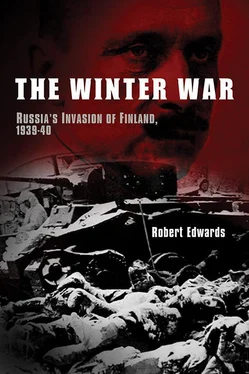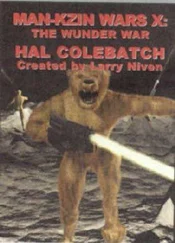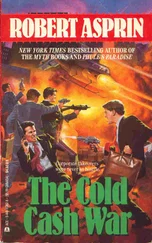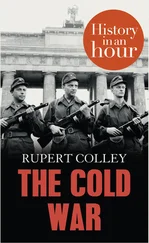Chew, The White Death, p. 69.
But when they did, it was outside all Finnish experience.
See Goodrich, Study in Siso, p. 74.
The text of the King’s Christmas message was, as was customary, dispatched to the media globally. He was after all not only king; he was the king emperor and the constitutional ruler of the biggest empire the world had ever known: ‘King of practically everything’ as one commentator had it. The general response to the quotation he had used was quite extraordinary; cables flooded in requesting the authorship of this simple, trite message. It transpired that it had originated in 1908, by the hand of one Minnie Louise Haskins, an expatriate American lecturer at the LSE, by then retired, who became rather famous as a result.
Daily Sketch.
Although Mannerheim himself, it seems, followed the Orthodox Russian faith.
Meretskov, Serving the People, cited by van Dyke, Soviet Invasion of Finland , ch. 3.
From their actions, we can only assume that this order went out to the Isthmus alone, for those elements of the Red Army who were in a fit state to attack proved themselves quite willing to do so, particularly at Kollaa.
And a decorated one.
Timoshenko would learn, in 1941, that militarily it was far from that.
According to a telegram received from Ambassador Schoenfeld in Washington on 8 January, the Finns acknowledged receiving German and Italian munitions via Sweden up to this date. They assumed it was Göring’s doing. Langer & Gleason, The Challenge to Isolation, vol. I, p. 340.
And the day after Daladier had announced to a cheering Chamber of Deputies that France intended to help the Finns ‘in no half hearted manner’.
See Home, To Lose a Battle , p. 116.
Ibid., p. 118.
The Scum of the Earth, cited by Home, ibid., p. 116.
Ironside Diaries, p. 186.
US Chief Counsel, Nazi Conspiracy and Aggression, Vol. VI, p. 981.
As opposed to a ‘useful idiot’, although not all would agree.
The next British ambassador to Moscow would be Stafford Cripps, but not until July 1940. Accordingly, for the rest of this conflict, neither Britain nor France had diplomatic representation in Moscow.
Kollontay had also been an advocate of ‘free love’ and went ahead to demonstrate exactly what she meant by that. The prudish Lenin did not approve, although Leon Trotsky might well have done.
Documents on German Foreign Policy, Series D, Vol. VIII, no. 521, January 10 1940.
W. P. & Zelda Coates, The Soviet-Finnish Campaign, pp. 137-8. It is astonishing that this book was even published in Britain—but the Soviet Union was in the war by then.
Cripps Diary, 17 January 1940. See Clarke, The Cripps Version, p. 157 and Cooke, The Life of Stafford Cripps, pp. 258-9.
Clarke, ibid. , p. 158.
Tanner, The Winter War, p. 124.
ibid., p. 125.
Ex CIGS, now commander of the BEF in France.
Cadogan Diaries (ed. D. Dilks), p. 241: ‘H [Halifax] told me Hore-Belisha must be got out of War Office.’
Ironside Diaries, p. 192.
Ibid., p. 193.
Channon Diaries (ed. R. James), 5 January 1940.
Because of Hore-Belisha’s Jewish ancestry, he was routinely called by this sobriquet in Whitehall.
Although Ironside does not appear to have been involved in the cabal.
The Thomas Walton, the Deptford (both carrying Swedish ore for Britain) and the Greek vessel Garaufalia, were all sunk 11-13 December 1939 by U-boats within the territorial waters of Norway.
Soviet Documents on Foreign Policy, (ed. J. Degras), pp. 416-20.
Documents on German Foreign Policy, Vol. VD3, Series D, n. to 503. (Emphasis mine).
Documents on German Foreign Policy, D, VDJ, No. 515.
W. S. Churchill, The Second World War, vol. I, p. 438.
Fall Gelb, Directives No. 6/7/8, 9 October—20 November 1939.
He would commit suicide shortly afterwards.
Not only in the West— ‘this was the time to settle the Leningrad problem: it was the time when other countries were busy elsewhere…’ Stalin (after the event) 17 April 1940. Chubaryan & Shukman, Stalin and the Soviet-Finnish War, p. 264.
See H. R. Trevor-Roper, Hitler’s War Directives. Also Haider Diary (eds. Burdick & Jacobsen), p. 90.
Appointed British military attaché in Helsinki.
A similar price to the two most expensive single fortifications on the Mannerheim Line, and at twice the price that the British government paid for them. However, familiarization and training was also included.
From Harold Macmillan, who was pitiless in his critique of Chamberlain’s policy.
Feiling, The Life of Neville Chamberlain, p. 436.
The hakaristi— honked cross—motif, the swastika, was originally a family emblem of the von Rosen family, who donated some aircraft decorated with it to the Finns in 1918. It was thus adopted as a Finnish emblem—it is a not uncommon Nordic symbol (as well as an oft-found Hindu one). The Nazis, who adopted it in 1920, obviously preferred the northern association.
Interestingly, they were described as ‘English Spitfires’ by Corps Commander Ptukhin, head of the North Western Front Air Arm, 1940. See Chubaryan & Shukman, op.cit., p. 125.
Charmley, Churchill: The End of Glory, p. 380; Gripenberg, Finland and the Great Powers, p. 112, printed record—Churchill archive.
Gilbert, Finest Hour .
Halifax had included with his note a digest of purely negative responses, collated by E. H. Carr.
The Goebbels Diaries, 18 January 1940, p. 102.
Documents on German Foreign Policy, Series D, vol. VIII, no. 565.
Günther would remain in office until 1945, Koht until 1941, i.e. well after the German occupation.
Читать дальше











